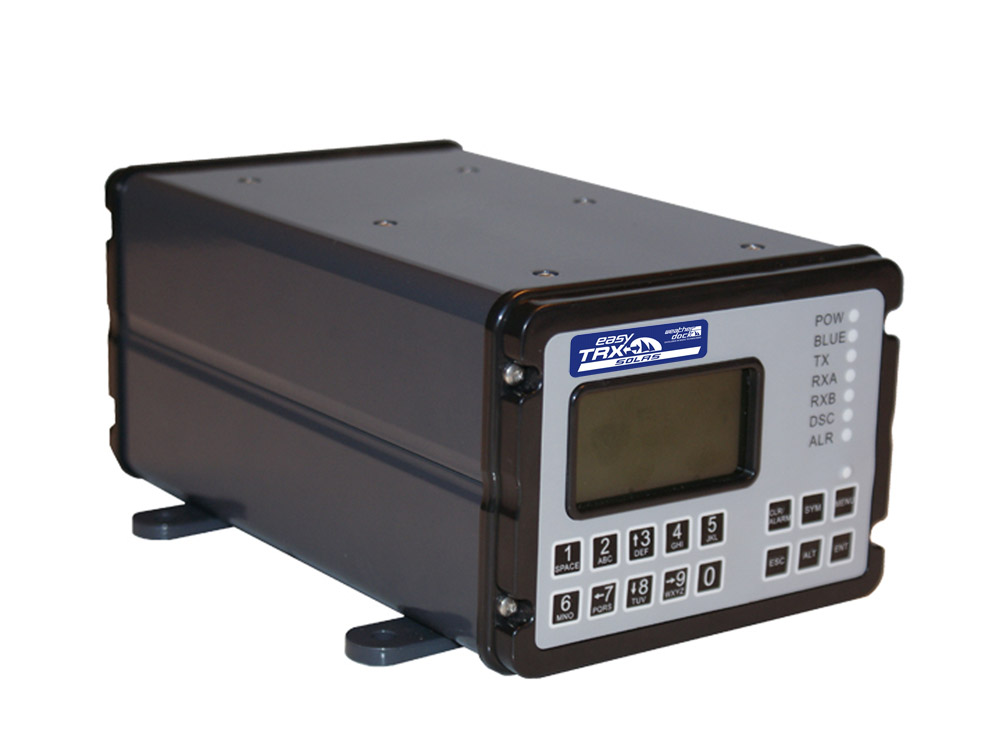Documents
AIS Class A | Inland Transponder in cooperation with CNS Systems™
- Increased situational awareness for inland navigation, the system communicates the blue sign for inland waters.
- The AIS transponder can be configured to operate either as an AIS Inland or a Class A transponder.
- The system communicates required static, voyage related and dynamic data.
The easyTRX – SOLAS AIS Class A/Inland transponder provides SOLAS compliance and BSH certification at very attractive prices. The easyTRX – SOLAS AIS Inland transponder is based on the well proven AIS Class A transponder of CNS Systems and developed in accordance with the latest AIS Inland standard requirements.
The AIS Inland transponder is type approved by Fachstelle der WSV für Verkehrstechniken FVT.
The data link communication covers standard AIS messages and the required static, voyage-related and dynamic data as well as blue sign messages for inland navigation for increased situational awareness and improved safety for the individual ship.
The data link communication covers standard AIS messages and the required static, voyage-related and dynamic data as well as blue sign messages for inland navigation for increased situational awareness and improved safety for the individual ship.
The SOTDMA technology used in the AIS transponder transmits and receives information on all vessels within VHF coverage. This information includes position, identity, course over ground, heading, and rate of turn as well as navigational status and the destination of the ship.
The AIS Inland transponder broadcasts Inland blue sign status messages for upstream or downstream navigation; ships passing on starboard side, hazardous cargo carriage (Blue Cones), and estimated time of arrival at locks, bridges and terminals. Lock management, information on draught, type of cargo and destination is vital for decision making and safe maneuvering along the inland waterways.
The information received from, and provided to, the ships is easily plotted on any ARPA radar or electronic chart system. Maximum situational awareness is accomplished.
Configuration and interfaces
The AIS Class A/Inland transponder is easy to install onboard any ship by connecting it to a GPS and VHF antenna, and is complete after connecting it to the onboard sensors. To maximize the benefi t of the investment, the AIS Inland transponder is delivered with an interface to the Inland ECDIS and/or ARPA radar.
The AIS Class A/Inland transponder consists of an integrated Minimum Keyboard and Display (MKD).
| Power | |
| Input voltage | 11-36 V DC |
| Radio | |
| Transmitter output power (adjustable) | 1 and 12.5 W, 50 Ohm load |
| Bandwidth | 25 kHz |
| Protocol | TDMA (AIS) |
| Baud rate | 9600 bps (AIS) / 1200 bps (DSC) |
| Modulation | GMSK (AIS) / FSK (DSC) |
| Frequencies | 156.025 MHz – 162.025 MHz |
| Default channels | 87B (161.975 MHz), 88B (162.025 MHz), 70 (156.525 MHz) |
| Number of receivers | 3 (2 AIS TDMA, 1 DSC) |
| Receiver sensitivity, | 20% MER < – 107 dBm |
| GNSS Receiver | |
| GNSS receiver | GPS L1, 50 parallel channels |
| DGNSS support | Yes |
| Environmental | |
| IEC 60945 | Protected installation |
| Interfaces | |
| VHF antenna | N female, 50 Ohm |
| GPS antenna | TNC female, 50 Ohm |
| Power | 3-way plugable screw terminal |
| Sensor Interfaces | 1 to 3 (RS422) IEC 61162-1 or -2 |
| Pilot/Auxiliary (RS422) | IEC 61162-2 |
| External Display (RS422) | IEC 61162-2 |
| Long-Range (RS422) | IEC 61162-2 |
| Blue sign interface | Discrete Input 24 V DC / Open |
| DGNSS correction input (RS232) | RTCM/SC-104 |
| Alarm relay | Normally closed |
Standards
ITU-R M.1371-4
IEC 61993-2
IEC 61162-1, 2
IMO Resolution A.694 (17)
IMO Resolution MSC.74 (69) Annex 3,
TU-R M.825-3
ITU-R M.1084-3,
EC 61108-1,
EC 62288
IPC-A-610 (manufacturing)
RTCA/DO-178B (SW development)
CCNR Vessel Tracking and Tracing Standard for Inland Navigation version 1.01
| Physical characteristics | |
| GNSS receiver | GPS L1, 50 parallel channels |
| DGNSS support | Yes |
Integrated MKD on the front panel
Plugable screw terminals for cable connections
Accessories included
Compliance
BSH Statement of Conformity
FVT type approved

